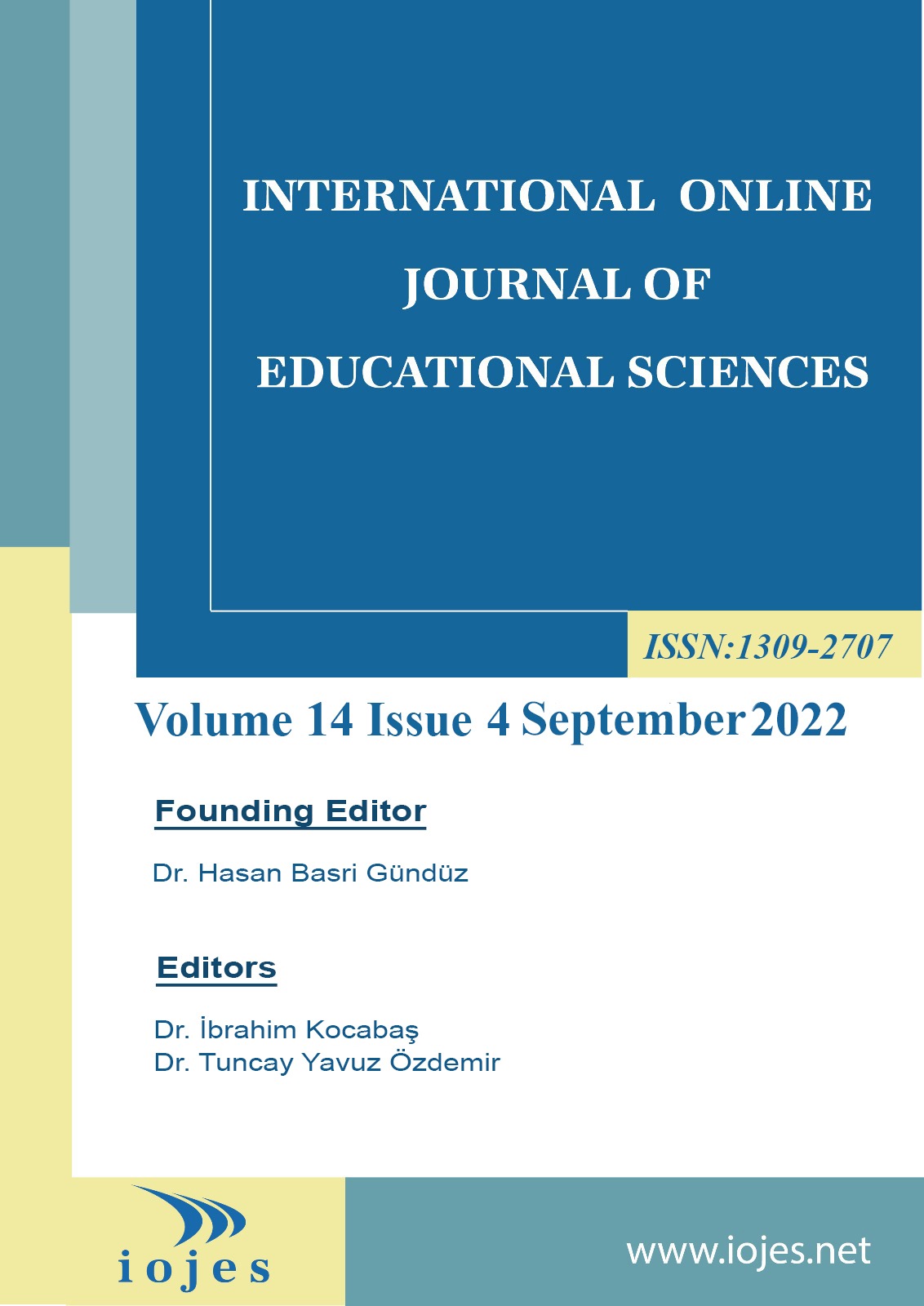Examining Secondary School Students’ Listening Anxiety in Terms of Different Variables and Determining the Causes of Anxiety
Author :
Abstract
Keywords
Abstract
This study aims to identify the listening anxiety levels and causes of secondary school students; to detect the differentiation status of anxiety in terms of various variables. An open-ended mixed-method model, which is a way of both quantitative and qualitative research methods, is used in this research. The scale of Listening Anxiety for Secondary School Students and the Frequency of Use of Listening/Monitoring Strategies is utilized to get quantitative data. A structured Interview Form is conducted to get qualitative data. Parametric tests were used to analyze quantitative data, and Content analysis was performed to analyze qualitative data. The study sample consists of 400 students in 5,6,7, and 8th grades in Malatya Yeşilyurt in the second period of the 2019-2020 educational term. Interviews with thirty-two students having high listening anxiety at different class levels and genders constitute the research's qualitative dimension. Findings of the study revealed that secondary school students differed in their listening anxiety based on gender, class level, parental educational status, the time listening materials at home, materials used in listening texts, use of listening strategies. No significant difference in the type of listening material has been identified. This study highlighted that secondary school students' listening concerns are mostly family-related problems, environmental problems, listening materials-related problems, attention deficit-related problems, psychological problems, problems due to lack of listening strategy knowledge.
Keywords
- Alisinanoğlu, F., & Ulutaş, İ. (2000). Çocuklarda kaygı ve bunu etkileyen etmenler. Milli Eğitim Dergisi, (145), 15-19.
- Aşılıoğlu, B. (2009). Türkçe öğretmen adaylarına göre derslerde karşılaşılan başlıca dinleme engelleri. Elektronik Sosyal Bilimler Dergisi, 8(29), 45-63 .
- Ateş, M. (2018). Ortaokul öğrencilerinin dinleme kaygılarının incelenmesi. 21. Yüzyılda Eğitim ve Toplum, 7(19) , 139-153.
- Başkan, A., & Deniz, A. (2015). Ortaöğretim öğrencilerinin ders içi dinleme sorunları. Turkish Studies, 10(7), 179-196.
- Ceyran, K. O. (2016). Türkçe öğretmeni adaylarının dinleme becerisine yönelik görüşlerinin incelenmesi. Yayımlanmamış Yüksek Lisans Tezi, Nevşehir Hacı Bektaş Veli Üniversitesi Sosyal Bilimler Enstitüsü, Nevşehir.
- Cihangir Çankaya, Z. (2015). Kişilerarası iletişimde dinleme becerisi. (3. basım).Nobel Yayıncılık.
- Çalıcı, M. A., & Aytan, T. (2020). Dinleme eğitimi (3. basım). Etkinliklerle dinleme eğitimi(T. Aytan, Ed.), Pegem Akademi.
- Doğan, B. (2017). Strateji temelli dinleme etkinliklerinin yedinci sınıf öğrencilerinin dinleme becerisiyle strateji kullanma düzeyine etkisi. Yayımlanmamış Doktora Tezi, İnönü Üniversitesi Eğitim Bilimleri Enstitüsü, Malatya.
- Doğan, Y. (2020). Dinleme eğitimi (7. Basım). Pegem Akademi.
- Girgin, G. (1990). Farklı sosyo ekonomik kesimden 13-15 yaş grubu öğrencilerde kaygı alanları ve kaygı düzeylerinin başarıyla ilişkisi. Yayınlanmamış Yüksek Lisans Tezi, Dokuz Eylül Üniversitesi Sosyal Bilimler Enstitüsü, İzmir.
- Grognet, A., & Van Duzer, C. (2002). Listening skills in the workplace. https://eric.ed.gov/?id=ED468604 adresinden 10.11.2020 tarihinde alındı.
- Kılınç, A. (2021). Ortaokul 5. Sınıf ög ̆rencilerinin dinleme üstbilişsel farkındalıkları ile dinledig ̆ini anlama becerileri arasındaki ilişki.Yayımlanmamış Yüksek Lİsans Tezi, Pamukkale Üniversitesi Eğitim Bilimleri Enstitüsü, Denizli.
- Kılınç, N. (2018). Türkçeyi yabancı dil olarak öğrenenlerin dinleme kaygılarının incelenmesi. Yayımlanmamış Yüksek Lisans Tezi, Nevşehir Hacı Bektaş Veli Üniversitesi Sosyal Bilimler Enstitüsü, Nevşehir.
- Karadüz, A. (2010). Türkçe ve sınıf öğretmeni adaylarının dinleme stratejilerinin değerlendirilmesi. Erciyes Üniversitesi Sosyal Bilimler Enstitüsü Dergisi, 1(29), 39-55.
- Karasakaloğlu, N, & Bulut, B. (2012). Görsel destekli dinleme metinlerinin anlamaya etkisi. NWSA-Education Sciences, 7(2), 722-733.
- Kemiksiz, Ö. (2022). Türkc ̧e öğretiminde kaygı üzerine yapılan çalışmaların eğilimleri. Manisa Celal Bayar U ̈niversitesi Sosyal Bilimler Dergisi, 20(1), 31-48.
- Kocaman, F., & Ersoy, A. (2021). Pandemi sürecinde öğrencilerin uzaktan eğitime ilişkin yaşadığı stres ve kaygı durumları: Nitel bir çalışma. International Journal of Contemporary Educational Studies (IntJCES), 7 (1), 2458-9373.
- Li, R. (2022). Examining foreign language listening anxiety and its correlates: A meta-analysis. Porta
- Melanlıoğlu, D. (2013a). Ortaokul öğrencileri için dinleme kaygısı ölçeğinin geçerlik ve güvenirlik çalışması. Adıyaman Üniversitesi Sosyal Bilimler Enstitüsü Dergisi, 6(11), 851-876.
- Melanlıoğlu, D. (2013b). Ortaokuldaki dinleme eğitiminin niteliğine ilişkin fenomografik bir araştırma. Okuma Yazma Eğitimi Araştırmaları, 1(1), 34-44.
- Melanlıoğlu, D. (2016). Yabancı öğreniciler için dinleme becerisine yönelik üstbilişsel dereceli puanlama anahtarı. Erzincan Üniversitesi Eğitim Fakültesi Dergisi, 18(2), 1206-1229.
- Movahed, R. (2014). The effect of metacognitive strategy instruction on listening performance, metaconitive awareness and listening anxiety of beginner Iranian Efl students. International Journal of English Linguistics, 4(2), 88-99.
- Pan, Y. (2016). Analysis of listening anxiety in Efl class. International Journal on Studies in English Language
- Selam, Ç. (2019). Ortaokul öğrencilerinin dinleme kaygılarının kullandıkları öğrenme stilleri ve çeşitli değişkenler açısından incelenmesi . Yayımlanmamış Yüksek Lisans Tezi, Çanakkale Üniversitesi Eğitim Bilimleri Enstitüsü, Çanakkale.
- Uçgun, D. (2016). Ortaokul öğrencilerinin okuma ve dinleme kaygıları arasındaki ilişkinin incelenmesi. Uluslararası Türkçe Edebiyat Kültür Eğitim Dergisi, 5(4), 1958-1970.
- Uğur, M. (2019). Dinleme stratejileri öğretiminin dinleme öz yeterlik algısına ve dinleme başarısına etkisi. İzmir: Yayımlanmamış Yüksek Lisans Tezi, Dokuz Eylül Üniversitesi Eğitim Bilimleri Enstitüsü.
- Varol, Ş. (1990). Lise son sınıfı öğrencilerinin kaygı düzeylerini etkileyen bazı etmenler. Yayınlanmamış Yüksek Lisans Tezi Ondokuz Mayıs ÜniversitesiSosyal Bilimler Enstitüsü, Samsun.
- Wolvin, A. (2010). Listening and human communication in the 21st century . WILEY BLACKWELL.
- Xu, F. (2011). Anxiety in EFL listening comprehension. Theory and Practice in Language Studies, 1(12),
- Yıldız, D. (2021). Dinlemenin edimsel ve duyuşsal boyutu. N. Bayat (Ed.), Dinleme ve eğitimi (1. Basım) (s. 27- 44). Anı Yayıncılık.
- Yalçın, A. (2012). Türkçe öğretim yöntemleri ve yeni yaklaşımlar. (3. basım).Akçağ Yayınları.





